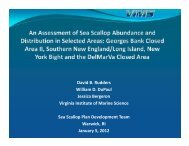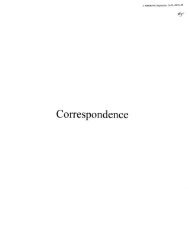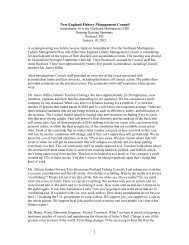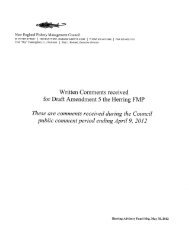Smooth Bottom Net Trawl Fishing Gear Effect on - New England ...
Smooth Bottom Net Trawl Fishing Gear Effect on - New England ...
Smooth Bottom Net Trawl Fishing Gear Effect on - New England ...
You also want an ePaper? Increase the reach of your titles
YUMPU automatically turns print PDFs into web optimized ePapers that Google loves.
NOAA/NMFS Unallied Science Project, Cooperative Agreement NA16FL2264 December 2005<br />
<str<strong>on</strong>g>Smooth</str<strong>on</strong>g> <str<strong>on</strong>g>Bottom</str<strong>on</strong>g> <str<strong>on</strong>g>Net</str<strong>on</strong>g> <str<strong>on</strong>g>Trawl</str<strong>on</strong>g> <str<strong>on</strong>g>Fishing</str<strong>on</strong>g> <str<strong>on</strong>g>Gear</str<strong>on</strong>g> <str<strong>on</strong>g>Effect</str<strong>on</strong>g> <strong>on</strong> the Seabed:<br />
Investigati<strong>on</strong> of Temporal and Cumulative <str<strong>on</strong>g>Effect</str<strong>on</strong>g>s BKAM/CR<br />
and appeared in relatively equal numbers during all three sampling dates. The lower number of<br />
invertebrates in the northern regi<strong>on</strong> of Mud Hole appears to be a direct reflecti<strong>on</strong> of fewer sea<br />
stars in this hard, flat mud regi<strong>on</strong>. Varying numbers of shrimp appear to be resp<strong>on</strong>sible for the<br />
observed seas<strong>on</strong>al shifts in the abundance of invertebrates. In Mud Hole, shrimp were a<br />
dominant comp<strong>on</strong>ent of the invertebrate fauna <strong>on</strong>ly in July and <strong>on</strong>ly in the southern regi<strong>on</strong>. In<br />
Little Tow, shrimp were abundant in both July and October, with the highest abundances<br />
observed in October. Rock crabs (Cancer spp.) were present in all areas during all seas<strong>on</strong>s, but<br />
were never found in very high numbers. Sand dollars were <strong>on</strong>ly observed in the sand wave<br />
regi<strong>on</strong> in the southern porti<strong>on</strong> of Little Tow at 4B in October and at 3B and 4B in November. An<br />
unidentified encrusting sp<strong>on</strong>ge was a dominant inhabitant of patches of cobbles and boulders<br />
found at 3A in Little Tow in October and November.<br />
<str<strong>on</strong>g>Trawl</str<strong>on</strong>g>ed verses C<strong>on</strong>trol Areas<br />
Overall, the abundance of megafauna did not appear to be affected by the chr<strong>on</strong>ic experimental<br />
trawling (Tables 3.3-3 and 3.3-4). No c<strong>on</strong>sistent differences were found between the trawled and<br />
c<strong>on</strong>trol areas. It was also interesting to notice that trawling did not appear to alter the overall<br />
faunal compositi<strong>on</strong>. Additi<strong>on</strong>ally, similar seas<strong>on</strong>al distributi<strong>on</strong> trends and shifts in faunal<br />
dominants were observed in both trawled and c<strong>on</strong>trol areas.<br />
In Mud Hole, the fish fauna was dominated by flounder and silver hake in July and October and<br />
by red hake and flounder in November (Figure 3.3-7a). Several small differences between<br />
trawled and c<strong>on</strong>trol areas were noted in Mud Hole. Flounder were slightly less abundant in the<br />
experimental areas in July and October, but not in November. In c<strong>on</strong>trast, in October and<br />
November silver hake were <strong>on</strong>ly seen in the trawled areas. However, when looked at in greater<br />
detail these differences were not c<strong>on</strong>sistently found in all areas and may be a reflecti<strong>on</strong> of faunal<br />
patchiness (Figure 3.3-8). In Little Tow, the fish fauna was dominated by flounder and silver<br />
hake in July and flounder and red hake in November, and was very depauperate in October<br />
(Figure 3.3-7b). No c<strong>on</strong>sistent differences between trawled and c<strong>on</strong>trol areas were noted in Little<br />
Tow. Flounder were more abundant in the trawled areas in July and November, and red hake<br />
were more abundant in the c<strong>on</strong>trol areas in November. Again, these differences appear to reflect<br />
a high degree of faunal patchiness (Figure 3.3-8). The invertebrate fauna also does not reflect<br />
any c<strong>on</strong>sistent differences between the trawled and c<strong>on</strong>trol areas (Figure 3.3-9a and Figure 3.3-<br />
9b). The <strong>on</strong>ly major difference that was noted was a higher number of shrimp in the c<strong>on</strong>trol areas<br />
in Little Tow in October, than in the trawl areas. This increase was noted in all three of the<br />
c<strong>on</strong>trol areas and thus does not appear to reflect faunal patchiness (Figure 3.3-6).<br />
3.3.2 Comparis<strong>on</strong> with 2001 results<br />
Very few valid comparis<strong>on</strong>s can be made between the 2001 and 2002 video data. The<br />
experimental design and the survey techniques differed substantially between the studies. The<br />
2001 study c<strong>on</strong>ducted intense experimental trawling at <strong>on</strong>e point in time and was oriented toward<br />
assess the immediate effect of trawling. In c<strong>on</strong>trast, the 2002 study was c<strong>on</strong>ducted over a period<br />
of time to assess the effects of chr<strong>on</strong>ic, lower intensity trawling. The 2001 study mainly used<br />
data collected from footage obtained from a video-sled operated in a towed mode and from a<br />
remotely operated vehicle (ROV). The data for the 2002 study c<strong>on</strong>sisted entirely of data<br />
41







